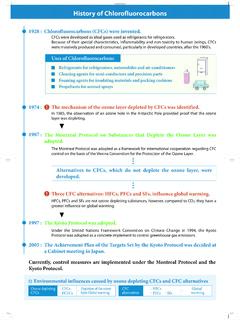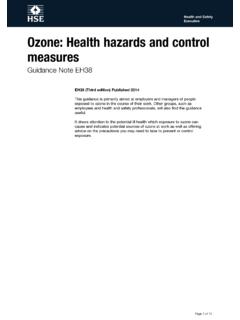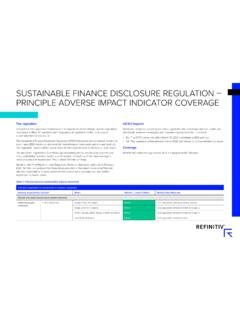Transcription of PREVENTION
1 PREVENTION . QUICK FACTS Laws making workplaces, restaurants, and bars Actions such as the Clean Air Act as well completely smoke-free can reduce heart attack as anti-smoking hospitalizations by 8% 17% within a ,5,6. campaigns have had a significant preventive Federal laws that address air quality have impact on public ,2,3. contributed to a decrease of 54% of six common States play a crucial role air pollutants since in promoting both local and federal PREVENTION efforts and also contrib- ute to PREVENTION through INTRODUCTION. their own ,3. The health of the American public has improved on many fronts over Beyond individual the last decades from decreasing incidence of lung cancer in men PREVENTION efforts, local to large reductions in the number of childhood lead poisoning cases. community actions can But as previous modules highlight, many diseases and illnesses are be particularly effective increasing in frequency.
2 Though the reasons for these increases are often in bringing about changes unknown, to the extent that the causes are recognized or suspected, that prevent or reduce preventive measures are desirable. Public health focuses on PREVENTION environmentally-related of disease and health promotion rather than the diagnosis and treatment illness and of diseases. WHAT IS PREVENTION ? PREVENTION activities are typically categorized by the following three definitions: 1. Primary PREVENTION intervening before health effects occur, through measures such as vaccinations, altering risky behaviors (poor eating habits, tobacco use), and banning substances known to be associated with a disease or health ,9. 2. Secondary PREVENTION screening to identify diseases in the earliest stages, before the onset of signs and symptoms, through measures such as mammography and regular blood pressure 3.
3 Tertiary PREVENTION managing disease post diagnosis to slow or stop disease progression through measures such as chemotherapy, rehabili- tation, and screening for 2 PREVENTION PICTURE OF AMERICA. Most PREVENTION suggestions are primary or secondary PREVENTION efforts for individuals. Yet, in the context Figure 1. The Spectrum of Prevention8. of environmental health, PREVENTION is much broader, because exposure to many contaminants is beyond the control of individuals and historically has been most effectively reduced by government programs Influencing Policy and and regulations12 ( , Pollution PREVENTION Act13; Legislation Clean Air Act1). Traditionally, environmental public health has focused on reducing exposure to environ- mental hazards known to be related to disease. Increasing emphasis is placed on upstream inter- ventions eliminating the source of the hazard Mobilizing neighborhoods rather than just preventing or reducing This type of elimination has often required action and communities by individuals as well as governments at the federal, state, and local levels.
4 THE PREVENTION FRAMEWORK. Fostering coalitions LOCAL PREVENTION and networks Beyond individual PREVENTION efforts, local commu- nity actions can be particularly effective in bringing about changes that prevent or reduce environmen- tally-related illness and disease. Strategies ranging from community education to neighborhood aware- Changing internal ness around an environmental health issue are some practices and policies of of the actions that can be taken at the local level. Zoning laws that provide incentives for the creation agencies and institutions of bike paths or that reduce the number or density of liquor stores are actions taken by local govern- ments for the benefit of a Information sharing between neighborhood associations, faith Educating healthcare communities, community-based organizations, and providers and other other local groups can highlight gaps in service and professionals facilitate coordinated efforts to achieve public health outcomes.
5 STATE PREVENTION . States play an important role in promoting both Promoting local and federal PREVENTION efforts and also contrib- community ute to PREVENTION through their own initiatives. For example, inspections and regulation enforce- education ment at food service establishments, swimming pools, hazardous waste disposal sites, and other locations help prevent illness and disease statewide. State-sponsored efforts support health screening Strengthening programs, anti-smoking campaigns, and health individual knowledge education. As partners with federal agencies, states and skills assist in implementation of programs such as the CDC's Childhood Lead Poisoning PREVENTION Program and the CDC's National Heart Disease and Stroke PREVENTION Program. PREVENTION 3. NATIONAL PREVENTION KEY COMPONENTS OF PREVENTION16.
6 National PREVENTION activities include initiatives, Individual, local, state, and federal efforts to prevent regulatory programs, and policies that establish environmentally-caused illness and disease have had nationwide programs to reduce both the presence some success, but a more comprehensive effort would of and exposure to harmful agents in the environ- be useful in meeting the overall environmental health ment ( , the Clean Water Act, National Tobacco challenges facing the United States. The following Control Program, National Asthma Control activities and initiatives can lead to understanding Program). Many agencies are involved in activities and reducing the nation's incidence of environmentally- that either directly or indirectly reduce public caused disease. exposure. The Department of Health and Human Services, which includes the CDC and the AWARENESS AND EDUCATION.
7 Food and Drug Administration; the Environmental Inform and educate decision-makers, public health Protection Agency (EPA); the Department practitioners, health care providers, and individuals of Housing and Urban Development (HUD); and about science-based health PREVENTION approaches the Department of Agriculture (USDA) all have that will have the greatest benefit and impact a hand in PREVENTION efforts. on public health. Provide information on effectiveness of interven- tions to inform policies. Educate workers both in and out of the health field who may have daily contact with people at high risk for disease and injury. These individuals can encourage healthy behaviors, screen for certain health risks, and contribute to education of the Provide the public with health education information.
8 Work with the media to highlight public health issues. 4 PREVENTION PICTURE OF AMERICA. Establish programs to proactively distribute informa- tion to targeted groups those at high risk for disease or injury. Research Identify and support an environmental public health research agenda at the national level. This research would address knowledge gaps in suspected and emerging links between exposure to harmful environ- mental agents and health outcomes. Surveillance at all levels Monitor environmental risk areas or situations and determine the prevalence of environmentally-linked health outcomes. Identify national, state, or commu- nity environmental health issues; develop measures to track those issues; and implement widespread surveillance to help identify relationships between environmental hazards and health concerns.
9 Hazard evaluation at the national, state, and local levels Implement hazard assessments as needed. Respond to high-risk situations, identify and quantify hazard- ous agents, and facilitate exposure reduction. Improvement of the public health system at the national, state, and local levels Enhance and revitalize the environmental health system at all levels. Build and improve long-term strategic partnerships, commitments by all stakeholders, and additional resources, as well as collaboration with environmental regulatory agencies and development of a competent and effective environmental public health Proactive behavior by individuals Make healthy lifestyle choices, choose environmental- ly-friendly products and services, and conscientiously try to minimize the environmental impact of yourself and your family.
10 Become informed about the issues, and be proactive in PREVENTION initiatives promoting health and preventing illness and disease. PREVENTION 5. THE NATIONAL ENVIRONMENTAL SUCCESSFUL PREVENTION INITIATIVES. PUBLIC HEALTH TRACKING Actions such as the Clean Air Act as well as anti- smoking campaigns have achieved a significant NETWORK preventive impact on public ,2,3 The following Many of the above activities are dependent on the success stories demonstrate how these initiatives relate availability of information to link diseases and to the advancement of environmental public health. environmental exposures. Laboratory studies contribute to our understanding, but without CLEAN AIR PREVENTION INITIATIVES. coordinated tracking of environmental hazards, One of the most substantial environmental pollution exposures, and diseases, the picture is often success stories has been the reduction in levels of air fragmented and inconclusive.














